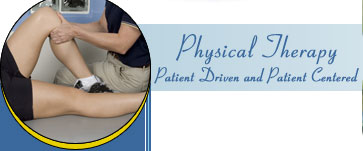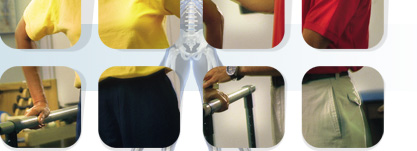|
Summit Peak Physical Therapy maintains an evidence-based practice to incorporate the latest treatments based on peer-reviewed research. It begins with a comprehensive evaluation of the musculoskeletal system using subjective review, objective special tests, and manual assessment of surrounding joints which could possibly contribute to pain or loss of motion. Following the examination, Dr. Moses takes time to explain the specific impairments and subsequent treatment plan. Goals are patient driven and monitored throughout the duration of therapy. Initial home exercise program will then be given and closely monitored at each pt visit for modifications according to patient tolerance and progression.
What type of services does Summit Peak Physical Therapy provide?
General Orthopaedic Rehabilitation
Orthopaedic rehabilitation includes a vast array of musculo-skeletal injuries and/or impairments such as: muscle strain, post-operative surgical repair of fractured bones, shoulder rotator cuff repair, low back pain, gait deviations, general weakness, etc.
Sports Medicine
Summit Peak specializes in the rehabilitation of sport-specific injuries. Focus is placed on adapting the treatment plan to reflect the athlete’s specific sport. A team approach with therapist, physician, coach, family, and athlete will improve the rehabilitation process. Dr. Moses is an avid road cyclist and racquetball player and has successfully treated many injuries stemming from multiple sports.
Manual Therapy
Manual therapy is an advanced form of treatment consisting of a passive form of mobilizing the specific joint to restore normal arthrokinematic range of motion. Before performing manual therapy it is crucial for the clinician and patient to understand the relationship between arthrokinematic and osteokinematic motion. Osteokinematic motion is defined as the relationship between a bone movement and its associated joint movements. For example, if you were just letting your arm hang down, when you moved it up to take something out of a cabinet above, your arm bone would be moving up (superior), however, your joint would be moving down or inferior to itself. This is due to the convex rule which states: if a convex joint surface is moving, the joint and bone movement is in opposite directions. Conversely, the concave rule states if a concave surface is moving the joint and bone movement are in the same direction. An example of concave rule would be the knee joint in the movement of the lower leg bone moving on the upper leg bone.
All these rules play a role in manual therapy because if you have movement restrictions within the joint the clinician must know how the joint moves in order to apply manual therapy to gain back some of the range of motion, or movement. Manual therapy consists of the clinician assessing the quality of movement within the joint, assigning the grade of movement from 0-6 (0-2 is hypomobile or restricted movement, 3 is normal movement, 4-6 is hypermobile, or increased movement), and determining what manual therapy mobilization should be used to restore lost movement.
The manual therapy mobilization consists of placing the specific bone and joint in its resting position, where the structures within the joint is the most lax position allowing for the greatest range of joint play. The clinician then applies his hands on the appropriate places on the bone and/or surrounding area to move the bone within the joint to increase the movement. These mobilizations should not cause any more pain and some of the mobilizations, depending on the grade of mobilization, may even reduce pain.
Summit Peak Physical Therapy does practice the grade V manipulation which is a high velocity, small amplitude movement in order to decrease movement restrictions. This technique is the one many people are familiar with when they “pop their back”; manual therapy terms this as a Grade V manipulation. These manipulations are only performed if it is indicated and most Grade V manipulation techniques are performed on the spine. Grade V manipulations, when used appropriately, are effective in decreasing pain and increasing range of motion within the manipulated joint. Patients will be educated regarding all manual therapy prior to the administration of techniques to reduce pain and restore lost movement.
Strength and Conditioning Exercise
Each patient has his or her own specific treatment plan according the subjective and objective findings at the initial examination. Exercise is paramount to a patient’s success in rehabilitation and it is used to improve balance, endurance, strength, and range of motion. A home exercise program will be designed for the patient and progression of home exercise program will be based upon pt’s tolerance and improvement. Exercise training may consist of all the following: core stabilization exercise, manual muscle energy techniques, balance training, and resistive exercise.
Soft tissue mobilization
Soft tissue mobilization is another form of manual therapy used to reduce muscular and surrounding tissue adhesions contributing to loss of range of motion or pain. Clinicians assess posture, examine surrounding musculature and soft tissue, measure range of motion, and evaluate the reproduction of symptoms to determine the area where soft tissue may be causing movement restrictions. Trigger points are areas within the muscles where the fibers have shortened causing tenderness and tightness. Soft tissue mobilization is used to lengthen the shortened fibers and train the involved musculature to function in its appropriate length. Soft tissue techniques commonly used are constant pressure over the trigger points to restore its appropriate length by using clinicians’ thumbs, knuckles, elbow, or wrist, passive stretching to shortened muscles, and exercise/education to maintain and train the muscles in its restored state.
Joint Replacement Rehabilitation
Patients who have undergone total knee or total hip replacement surgery are seen by one physical therapist and not in a group setting. Attaining an appropriate gait pattern, decreasing pain, gaining strength in surgical limb, increasing range-of-motion, and improving balance is vital to successful rehabilitation of those who undergo joint replacement surgery.
Motor Vehicle Injury Rehabilitation
Following a car accident the driver/passengers may receive trauma to various parts of the body. Common injuries we see include stiff neck, low back pain, and whiplash. Some injuries are too acute and cannot be treated early on; however, some injuries should be treated as soon as possible. If you are involved in a motor vehicle accident ask your primary care physician if physical therapy is appropriate for you.
Personal Training
One focus of Summit Peak Physical therapy is to strengthen and train all types of individuals. For those who weight train or would like to have further advanced training, please speak with Dr. Moses as he would be able to train using a one-on-one basis outside/inside the clinic based upon athletes’ needs. NOTE: this is a cash pay service only, if you would like further information please speak with Dr. Moses as each athlete requires a different training protocol, thus, flat rates do not apply.
Prevention of Injury
Our goal is to educate each of our patients regarding their specific physical therapy diagnosis and teach them how to prevent the same or other injuries in the future. This begins from the initial evaluation and does not cease at discharge. Any time a patient has a question regarding their rehabilitation or musculo-skeletal system after discharge we are more than happy to assist in explaining and teaching. Our intention is to educate our patients so they are able to return to their prior level of function and maintain what they have achieved.
Modalities
Modalities used at Summit Peak Physical Therapy include Interferential Electrical Stimulation (IFES), ultra sound (US), and muscle stimulation, (EMS/NMES). IFES and US are forms of treatment used to reduce pain, muscle spasms, and inflammation. Both treatments are relatively painless with most people not feeling anything at all. EMS and NMES are used to stimulate the strength of a particular muscle. When coupled with manual therapy and an appropriate exercise protocol these modalities are effective in reducing pain, inflammation, and muscle spasms.
Summit Peak Physical Therapy
-
All initial examinations and subsequent pt visits are all one-on-one with Dr. Moses.
-
Dr. Moses is a Fellowship trained, double board certified musculo-skeletal specialist in the restoration of functional mobility, injury prevention, and the science of human movement.
|




